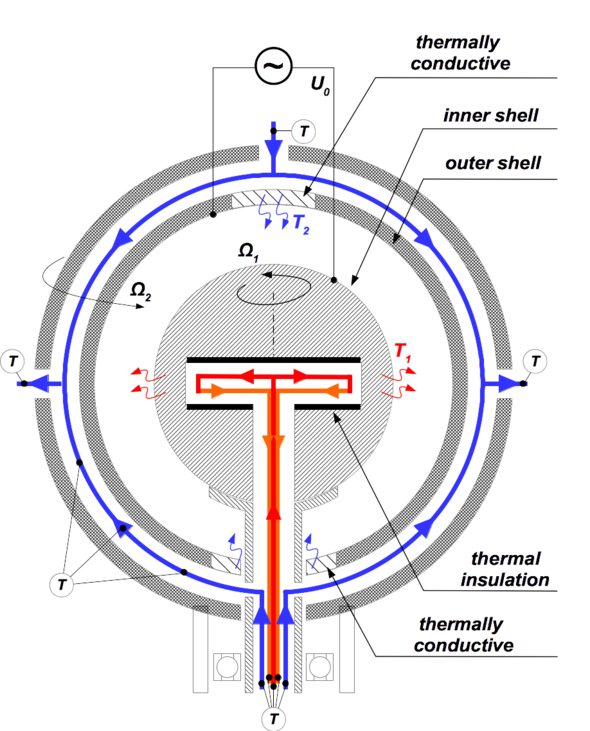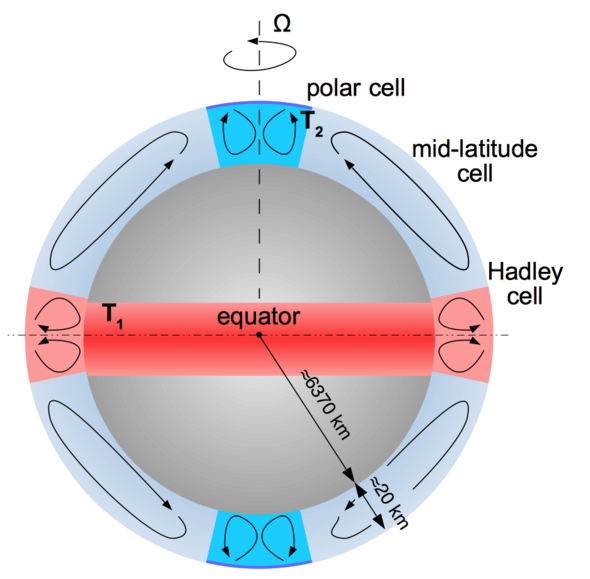Space Applications
Atmoflow
Introduction
The main objective of the AtmoFlow experiment is the investigation of convective flows in the spherical gap geometry. Gaining fundamental knowledge on the origin and behavior of flow phenomena such as global cells and planetary waves is interesting not only from a meteorological perspective. Understanding the interaction between atmospheric circulation and a planet's climate, be it Earth, Mars, Jupiter, or a distant exoplanet, contributes to various fields of research such as astrophysics, geophysics, fluid physics, and climatology. AtmoFlow aims to observe flows in a thin spherical gap that are subjected to a central force-field. The Earth's own gravitational field interferes with a simulated central force-field with the given parameters of the model which makes microgravity conditions of g<10-3g0 (e.g. on the ISS) necessary. Without losing its overall view on the complex physics, circulation in planetary atmospheres can be reduced to a simple model of a central gravitational field, the incoming and outgoing energy (e.g. radiation) and rotational effects. This strongly simplified assumption makes it possible to break some generic cases down to test models which can be investigated by laboratory experiments and numerical simulations. Varying rotational rates and temperature boundary conditions represent different types of planets. This is a very basic approach, but various open questions regarding local pattern formation or global planetary cells can be investigated with that setup. A concept has been defined for developing a payload that could be installed and utilized on-board the International Space Station (ISS). This concept is based on the microgravity experiment GeoFlow, which has been conducted successfully between 2008 and 2016 on the ISS.
Scientific program and objectives
The AtmoFlow experiment makes it possible to investigate decoupled flows, which are driven only by internal heating, boundary temperature difference, rotation or complex boundary conditions. It will enable deep insights into EHD driven fluid flows, which can be used for validating simple convection models of planetary atmospheres. The extension of semi-empirical parameterizations of unresolved atmospheric processes, e.g. large-scale / small-scale coupling will be investigated, too. Furthermore, precise parametrization of cell formation will be tested with respect of e.g. Rhines scaling. This includes the investigation of the heat transfer from the tropics to the stably stratified mid-latitudes. In addition, the findings of AtmoFlow are expected to be of benefit for validation and development of models that deal with climate change. Various initial temperature distributions will be tested to investigate connections between external forcing and climate variability.
The main goal is the elucidation of basic aspects of convection in the rotating spherical shell. This allows the testing of linear stability analysis regarding base flows, convective onsets and bifurcation scenarios in rotating and non-rotating scenarios.
Geometry and thermal boundary conditions
The experimental cell, depicted in will rotate as a complete assembly and the inner sphere will be equipped with an additional drive unit to rotate relative to the experimental cell. The radius of the outer sphere is determined by the size and weight of the optical setup as well as the optical accessibility. This trade-off leads to a radius of outer sphere at 0.027m, a radius of inner sphere at 0.0189m, resulting in a radius ratio of 0.7. The radius of the inner sphere is further chosen to reach a radius ratio in between thin and thick atmospheres.
The key feature of AtmoFlow is the thermal boundary condition. Realistic atmospheric boundary conditions are very complex, however, it is possible to break them down to follow three regions:
a) a solar-heated equatorial region with absorption of re-radiated infrared radiation.
b) heat sinks in the upper atmosphere of the poles and mid-latitudes.
c) moderate temperature regions between the polar and the equatorial regions.
Imposing these idealized boundary conditions results in a global circulation, which is convectively unstable in the tropics and stable in the mid-latitudes. Hence, the heat transfer from the tropics to the stably stratified mid-latitudes and sub-tropics can be investigated with this setup. A baroclinic wave tank with the same specifications has been investigated by Scolan at al. (2017). They observed the interaction and coexistence of convective and baroclinic zones. Hence, this experiment can be used as validator to study equilibrium processes as they occur in planetary atmospheres. For AtmoFlow the thermal boundaries are imposed by heating plates and cooling loops, which results in Dirichlet type boundary conditions. Convection is controlled by varying the temperature at the outer shell. The primary candidate as working fluid is 3M Novec 7200 (ethoxy-nonafluorobutane). It is a clear, colorless and is a low-odor fluid.
Numerical simulations
Accompanying numerical simulations are performed for the AtmoFlow experiment. They are used to reconstruct the velocity field, which is not accessible by measurement techniques used in AtmoFlow. The reconstruction is based on a comparison of experimental and numerical interferograms. Matching structures in both interferograms correlate with similar temperature and velocity fields. Based on this assumption, the three-dimensional fluid flow gets accessible. However, drift velocities of convective structures are used to support the comparison. The governing equations are solved numerically with the finite volume method (FVM) using the open source software suite OpenFOAM. A cubed spherical grid with 4 mio. cells is used for all simulations, where the radial resolution is 60 cells. The velocity boundary conditions are kept no-slip. The thermal boundaries are of Dirichlet type. The code solves the governing equations dimensionally in 3D with the PIMPLE algorithm. This algorithm is based on the SIMPLE approach for the solution of incompressible flows, but iterates the pressure loop several times to increase the precision of the solution. The time integration is performed with an implicit Crank-Nicolson method, the space derivatives are approximated in second order.
References
[1] F. Zaussinger, P. Canfield, A. Froitzeim, V. Travnikov, P. Haun, M. Meier, A. Meyer, P. Heintzmann, T. Driebe, Ch. Egbers. AtmoFlow - Investigation of atmospheric-like fluid flows under microgravity conditions. Submitted to Microgravity Science and Technology, 2019 (under review)
[2] F. Zaussinger, P. Canfield, T. Driebe, C. Egbers, P. Heintzmann, V. Travnikov, A. Froitzheim, P. Haun, and M. Meier. AtmoFlow - Simulating atmospheric flows on the International Space Station. Part II: Experiments and numerical simulations. In 69th IAC conference proceedings, volume 18.A2.7.18-69. International Astronautical Federation, September 2018.
[3] F. Zaussinger, C. Egbers, P. Canfield, P. Haun, V. Travnikov, and A. Froitzheim. AtmoFlow - Exper- imental investigation of atmospheric flows under microgravity conditions. In EGU General Assembly Conference Abstracts, volume 20 of EGU General Assembly Conference Abstracts, page 6273, Feb. 2018.
[4] H. Scolan and P. L. Read. A rotating annulus driven by localized convective forcing: a new atmosphere- like experiment. Experiments in Fluids, 58(6), May 2017.


